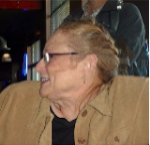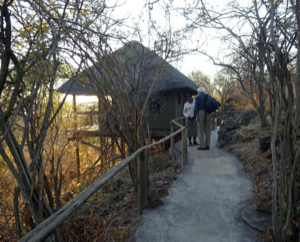Africa Safari
Botswana, Zambia, and Zimbabwe
July, 2013
We met with most of our fellow travelers this morning at breakfast in Johannesberg, and then Zona took us to get our shuttle to the airport and through passport security. We boarded an airbus 319-100 to fly to Victoria Falls. We were met by Abraham (Abi) Nyoni in Victoria Falls, Zimbabwe. Abi welcomed us, told us something about what to expect, and warned us not to take pictures of people we see on the street without permission. It is OK for us to photograph the people we see in the camps and in the village and school that we will be visiting. He also said that it is considered a sign of disrespect for people to look into the eyes of elders. If someone averts their eyes it is not a sign of rudeness, but rather respect.
At right is a map showing our routes and camps in southern Africa

Cast of Characters

Our tour guide leader,
Abraham (Abi) Nyoni


Marian Moran


June Kay


Judith Blecha


Arthur Kay


Marilyn Herel

Arthur Luehrmann

Martha Luehrmann

Winston Padgett


Monica and Scott Shephard


Polly Anna Randol

Janet Shi

Zona, who met us at the Johannesburg airport


Laura and Ken Westray


Our driver is Shamiso. We drove on the road that goes on to Cairo, Egypt. It is lined by Zambezi trees. We passed through the town of Victoria Falls (~30,000 people). Lots of red-clay soil.
Zimbabwe used to be the southern part of North Rhodesia. Zambia also used to be part of Rhodesia, and Malawi was in the Rhodesian federation. Nambia is the local language.
We turned north towards Boswana. We took some pictures of Hornbills at the side of the road, and we saw an elephant in the trees. Arthur saw a horned deer-like animal, but bigger. Lots of Umbrella Acacia trees. Saw the Zambezi River and Woolly Kepabush.

South African Airlines plane we flew from Johannesburg to Victoria Falls

ground hornbill

ground hornbill

The Chobe River, looking from Botswana to Nigeria

warthog



baobab tree




elephants

map of Botswana

life expectancy graph in Africa


elephant family


zebras


giraffe
Mr. Hippo went to God and asked if he could live in the water.
God said, “No. You are too big and would crowd out the fishes.”
Hippo pleaded, “But I need to live in the water to stay cool and to keep my skin from cracking.”
But God said, “No. You would eat my other creatures who come to the water to drink.”
Hippo said, “I promise not to eat any of your creatures, only plants.”
God said, “But how will I know that you haven’t eaten any of my creatures?”
Hippo said, “Whenever I see a human, I will open my mouth so he can see that I have no bones in my mouth.”
But God said, “How would he know that you hadn’t already swallowed the bones?”
Hippo said, “ OK. Whenever I make dung, I will scatter it with my tail so you can tell that there are no bones in it.”
And so, God let Mr. Hippo spend most of his life in the water

A warm singing welcome around the Baobab Camp dining room

warthogs coming up the gully below our camp - they spend much of the day browsing in the Chobe River floodplain, but like to retreat to the forest at night because of predators.

Our Baobab Camp host, Bonno



Arthur at our cabin overlooking the mouth of the gully

impalas

sunset over the Chobe River floodplain
Our cabin, #1, is GORGEOUS! It is at the mouth of this inlet from the flood plain. It is on stilts and has a thatched roof, but is very comfortable with a big bed with mosquito netting.




